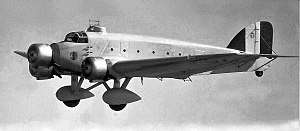Aviazione Legionaria
| Legionary Air Force Aviazione Legionaria | |
|---|---|
 A Savoia-Marchetti SM.81 during a bombing raid. The black crosses distinguishable in the tail are Saint Andrew's Cross, the insignia of the Spanish Nationalist Air Force (Franco's side). | |
| Active | 1936–1939 |
| Disbanded | 1939 |
| Country |
|
| Allegiance | King of Italy |
| Branch | Air force |
| Garrison/HQ | Son Bonet Aerodrome |
| Engagements | Spanish Civil War |
| Flying hours | 135,265 |
| Commanders | |
| Notable commanders |
Ruggero Bonomi Vincenzo Velardi Mario Bernasconi Adriano Monti. |
| Insignia | |
| Wing roundel |
 |
| Fuselage roundel |
 |
| Fin flash |
 |
| Aircraft flown | |
| Attack | Breda Ba.65 |
| Bomber | Fiat BR.20, Savoia-Marchetti SM.81 |
| Fighter | Fiat CR.32, Fiat G.50 |
| Reconnaissance | IMAM Ro.37, Caproni Ca.310s, Caproni A.P.1s, Breda Ba.28, Fiat C.R.20B |
| Trainer | IMAM Ro.41 |
| Transport | Savoia-Marchetti SM.81 |
The Legionary Air Force (Italian: Aviazione Legionaria, Spanish: Aviación Legionaria) was an expeditionary corps from the Italian Royal Air Force (Regia Aeronautica Italiana). It was set up in 1936 and sent to provide logistical and tactical support to the rebel faction after the Spanish coup of July 1936 which marked the onset of the Spanish Civil War. The air force alongside its Nazi German allies, the Condor Legion fought against the Spanish Republic and the Aviación Legionaria supported the Italian ground troops of the Corpo Truppe Volontarie. They served from August 1936 to the end of the conflict in March 1939. Their main base of operations was Majorca in the Balearic Islands.[1]
History
At the outbreak of the Spanish Civil War in July 1936, Francisco Franco, the leader of the rebel armies in Spanish North Africa, had about 30,000 troops and Moroccan nationals under his command, along with some artillery units. In order to transfer his troops and equipment to mainland Spain, on 24 July 1936, Franco turned to the Italian consul in Tangiers and then directly to Major Luccardi, the military attache at the Italian consulate. Through them Franco tried to convince Benito Mussolini to send twelve transport aircraft, twelve reconnaissance planes, ten fighter aircraft, 3000 aerial bombs, antiaircraft machine guns, and at least forty five transport ships. Mussolini was initially reluctant to send them, despite his sympathy for Franco, but, under pressure from his son-in-law Galeazzo Ciano, changed his mind on July 25. Ciano had in the meantime met with representatives of the Spanish monarchy to arrange the transfer of about thirty fighter planes and other equipment, which would arrive on August 2, sent by the French government.
On July 27 Mussolini ordered the under-secretary for the Regia Aeronautica, General Giuseppe Valle, to send 12 three-engined Savoia-Marchetti SM.81 bombers with crews and relevant specialists to Franco. These would form the first unit, initially known as Aviación del Tercio,[2] and set out at dawn on 30 July from Cagliari-Elmas on Sardinia, where they had picked up three officials from the Scuola di Navigazione di Altura at Orbetello, the 'gerarca' Ettore Muti, and Tenente-Colonnello Ruggero Bonomi. The aircraft crews and the specialists were all volunteers from 7th, 10th and 13th Stormo and were provided with civilian clothes and fake documents. All Italian insignia on the planes had been blotted out to avoid an international incident with pro-Republican European governments. Fake documents stated that the planes were being sold to the Spanish journalist Luis Bolin.
Not all of the Italian planes sent to aid the rebel faction reached Morocco - the plane commanded by Angelini crashed in the Mediterranean, Mattalia's crashed near Saïda in French Morocco, and Lo Forte had to make an emergency landing near Berkane (also in French Morocco) and was seized by the local authorities. The nine survivors of the Moroccan crashes were provided with nationalist papers and transportation to the airport at Tetuan, from which, over the following days, they helped escort the transport ships Araujo, Ciudad de Alicante, and Ciudad de Ceuta, which together carried 4,000 men, 4 artillery batteries, 2 million cartridges, and 12 tons of other munitions to mainland Spain.
Encouraged by the success of this first operation, Mussolini began sending a steady stream of munitions, personnel, and supplies under the name of Aviación Legionaria, Aviazione Legionaria.
Bombing operations
Besides military targets, the Aviazione Legionaria carried out a great number of strategic bombings of cities in the Spanish Republican rear area, intended to terrify the civilian population into surrender. The most significant of these was the 1936 Bombing of Madrid ordered by General Franco, in which the city's residential areas were subject to heavy bombardment —with the exception of the upper class Salamanca district, which was assumed to contain many Nationalist supporters. Three Italian bombers attacked the Renteria bridge on the outskirts of Guernika[3] prior to the Condor Legion's bombing of Guernica on April 26, 1937. This was followed by an attack on Almeria.[4]
It would be in 1938 that Italian planes carried out most of their large-scale bombing operations, striking the cities of Barcelona, Alicante, Granollers, and Valencia, as well as the railway stations of Sant Vicenç de Calders in 1938 and Xàtiva in 1939. With a total of 728 raids on Spanish Mediterranean cities, the Aviazione Legionaria dropped 16,558 bombs and inflicted numerous casualties.[4]
On 12 May 1939 the last Italian aircrew embarked for Italy on the ship Duilio at Cadiz. By the end of the conflict the Aviazione Legionaria had logged a total of 135,265 hours' flying time on 5,318 operations, dropping 11,524 tons of bombs and destroying 943 enemy air units and 224 ships. 171 Italian personnel had been killed and 192 wounded, with 74 fighters, 8 bombers, 2 ground-attack planes and 2 reconnaissance aircraft shot down or destroyed. The ratio of results to men and machines lost was positive, but also confirmed the Regia Aeronautica's commanders in their mistaken belief that biplanes and triplanes were still valid in modern combat. In fact the age of air warfare dominated by these aircraft was waning and it was becoming evident that radio needed to be mounted on all aircraft and that bomb-aiming needed to be done with special instruments rather than by sight[5] These errors of judgement would prove decisive when Italy entered the Second World War in 1940.
Aircraft and units
Twelve Fiat CR.32 biplanes arrived in Melilla aboard transport ships on 14 August 1936 (405 would be sent to Franco by the end of the operation), and by the end of August the Cucaracha squadron was formed at Cáceres with aircraft of that type. Initial dispatches of aircraft were followed by more numerous ones - in March 1939, eleven new Fiat G.50 monoplane fighters were sent, to be based at Ascalona, though ultimately they never saw action.
Various types of bombers were sent to Franco's forces, including 55 three-engined Savoia-Marchetti SM.81 Pipistrellos, 99 three-engined Savoia-Marchetti SM.79 Sparvieros, and 16 Fiat BR.20 Cicognas. The units were made part of the 21st Stormo da Bombardamento Pesante and the 251st and 252nd Squadriglia Pipistrelli delle Baleari. The Cicognas went to 230th Squadriglia da bombardamento veloce in summer 1937, before being transferred to the 231st in 1938.
Altogether a total of 764 airplanes were sent:
- Fiat CR.32, fighter (376 aircraft)[6]
- Fiat G.50, fighter (12)
- Fiat BR.20, bomber (13)
- Savoia-Marchetti SM.79, bomber/torpedo-bomber (100)[7]
- Savoia-Marchetti SM.81, bomber (84)[8]
- Breda Ba.65, ground attack aircraft (23)[9]
- Seaplanes, several types (20)[10] - Three SM.55 bombers and three M.41 fighters in August 1936; ten single-engined CANT Z.501 seaplanes in April 1937; four heavy three-engined CANT Z.506 seaplanes in July 1938.[11]
- Transport aircraft, several types (53 approximately)
- Troop carrier aircraft, several types, (10 approximately)
- Training and reconnaissance aircraft - 25 of the single-engined biplane IMAM Ro.41, 36 IMAM Ro.37s, 16 Caproni Ca.310s, 10 Caproni A.P.1s, 6 Breda Ba.28s, and a few Fiat C.R.20B
The 276 of these aircraft which survived at the end of the war were all transferred to the newly established Spanish Nationalist Air Force.
Markings
The unit's recognition symbols were roundels placed on both sides of the wings and on the tail-rudder. The wing symbol was a completely black circle, later personalized with white symbols ranging from a simple cross to designs referring to the commanders of the Condor Legion and the Aviación Nacional. The tail symbol was a simple black cross on a white field, which remained the fin flash of the later Ejército del Aire.
Personnel
In addition to the aircraft, Italy provided a number of well-trained men, sending more than 6,000 in total (5,699 airmen and 312 civilians). These men replaced Spaniards who had been killed.
Aces
| Name | Kills |
|---|---|
| Mario Bonzano | 15 |
| Adriano Mantelli | 12 |
| Corrado Ricci | 10 |
| Guido Nobili | 10 |
| Carlo Romagnoli | 9 |
| Giuseppe Cenni | 6 |
| Granco Lucchini | 5 |
| Enrico degli Incenti | 5 |
Source: Axishistory.com (12 July 2008)
Commanders
In its two and a half years in Spain the legion had four commanders (final ranks noted):
- Generale di Brigata Aerea Ruggero Bonomi, until December 1936
- Generale di Divisione Aerea Vincenzo Velardi
- Generale di Squadra Aerea Mario Bernasconi
- Generale di Divisione Aerea Adriano Monti.
See also
Notes
- ↑ Air War in the Spanish Civil War 1936-39
- ↑ Enciclopedia Ilustrada de la Aviación: Vol.3, pag. 682, Edit. Delta, Barcelona. 1982 ISBN 84-85822-38-2
- ↑ Guerra di Spagna e Aviazione Italiana. Uffficio Storico Stato Maggiore Aeronautica. p. 210.
- 1 2 Heiberg, Morte (2004). Emperadores del Mediterráneo: Franco, Mussolini y la guerra civil española. Barcelona: Crítica. ISBN 8484324702; p. 133
- ↑ (in Italian) Gianni Rocca, I Disperati - La tragedia dell'Aeronautica Italiana nella seconda guerra mondiale, ISBN 88-04-44940-3
- ↑ Ferdinando Pedriali op. cit.allegati
- ↑ THOMAS, Hugh. The Spanish Civil War. Penguin Books. 2006. London. p.938
- ↑ Pedriali Ferdinando op, cit. Allegati
- ↑ Pedriali Ferdinando op. cit. Allegati
- ↑ Pedriali Ferdinando op. cit. allegati
- ↑ Pedriali Ferdinando op. cit. , allegati
Bibliography
- (in Italian) Ferdinando Pedriali, Guerra di Spagna e Aviazione Italiana (1992, 2nd edition, Ufficio Storico dello Stato maggiore Aeronautica).
External links
| Wikimedia Commons has media related to Aviazione Legionaria. |
- (in Italian) Breve storia dell'Aviazione Legionaria italiana in Spagna by Carlo Rosselli
- (in Italian) La guerra civile spagnola - L'Aviazione Legionaria in http://www.finn.it/regia/index.htm%5Bpermanent+dead+link%5D Gli aerei della Regia Aeronautica].
- (in Italian) Commanding officers
- (in Italian) Photo gallery